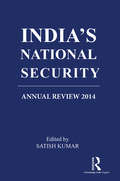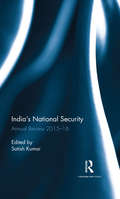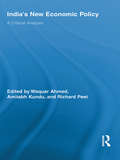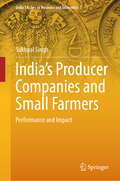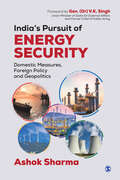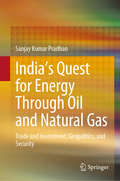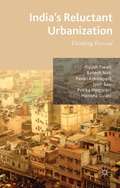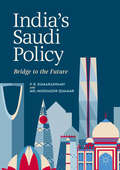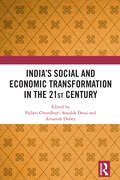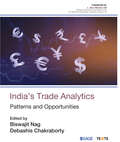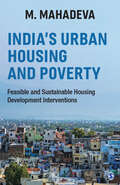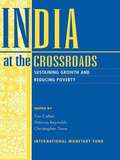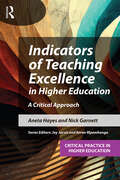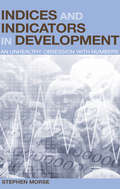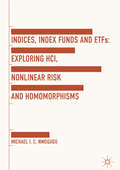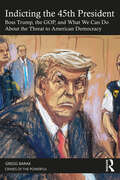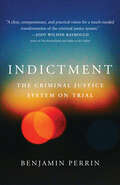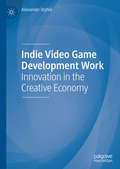- Table View
- List View
India's National Security: Annual Review 2014
by Satish KumarThis fourteenth volume of India’s National Security Annual Review intensively analyses India’s national security with respect to the changing internal and external dynamics. In the global environment, the situation is characterised by rising tensions between United States and Russia, intensified rivalry between United States (US) and China, and increasing cooperation between China and Russia. For India which seeks peaceful growth to emerge as a major power, this poses severe diplomatic challenges. This volume discusses the complexity of these challenges and the deftness with which India gets the best out of its strategic partnerships with the US and Russia while warding off the transgressions of a mighty adversary like China. It also studies the impact of internal convulsions and external intrusions on India’s security from South Asian nations such as Afghanistan, Bangladesh, Nepal and Sri Lanka. Examining the field of internal security, the essays carry rare insights into the causes of expansion of Naxalite violence in tribal areas and the dynamics of conflict resolution in the Northeast, as well as India’s deep concern as a growing power with its economic slowdown in the recent past, and energy and cyber security. Bringing together contributions from eminent scholars and diplomats, the volume will be indispensable for policymakers, government think tanks, defence and strategic studies experts, as well as students and researchers of international relations, foreign policy and political science.
India's National Security: Annual Review 2015–16
by Satish KumarThe last two years have witnessed deterioration in the global security situation characterised by increasing tensions among major powers. The threat perceptions of the US, China and Russia vis-à-vis each other have sharpened. There is stiff competition among them to dominate the strategic space in different parts of the world. This has led them to formulate national security strategies which are more assertive, aggressive and competitive. There is lack of consensus in resolution of conflicts in Afghanistan and Syria. There is no concerted effort in meeting the challenge of the Islamic State. It is in this fractured security environment that India has been making special efforts to project itself as a leading power commensurate with its economic and military potential. This fifteenth volume of India’s National Security Annual Review undertakes an incisive analysis of India’s endeavours to maximise its gains with respect to its strategic partners. The volume also focuses on the new dynamism that India has injected in its relations with countries in the Middle East and the Asia Pacific. India’s threat perceptions in its extended security zone, critical aspects of its strategic preparedness and complex issues regarding its internal security have been thoroughly examined. With contributions from experts from the fields of diplomacy, academia and civil and military services, the book will be one of the most dependable sources of analyses for scholars of international relations, foreign policy, defence and strategic studies, and political science, and practitioners alike.
INDIA'S NEW CAPITALISTS: Caste, Business, and Industry in a Modern Nation
by Harish DamodaranIt?s no secret that certain social groups have predominated India?s business and trading history, with business traditionally being the preserve of particular `Bania? communities. However, the past four or so decades have seen a widening of the social base of Indian capital, such that the social profile of Indian business has expanded beyond recognition, and entrepreneurship and commerce in India are no longer the exclusive bastion of the old mercantile castes. In this meticulously researched book ? acclaimed for being the first social history to document and understand India?s new entrepreneurial groups ? Harish Damodaran looks to answer who the new `wealth creators? are, as he traces the transitional entry of India?s middle and lower peasant castes into the business world. Combining analytical rigour with journalistic flair, India?s New Capitalists is an essential read for anyone seeking to understand the culture and evolution of business in contemporary South Asia.
India's New Economic Policy: A Critical Analysis (Routledge Studies in Development and Society)
by Waquar AhmedConventional interpretations of the New Economic Policy introduced in India in 1991 see this program of economic liberalization as transforming the Indian economy and leading to a substantial increase in the rate of India’s economic growth. But in a country like India, growth is not enough. Who benefits from the new growth regime, and can it significantly improve the conditions of livelihood for India’s 800 million people with incomes below $2.00 a day? This edited volume looks at international policy regimes and their national adoption under strategic conditions of economic crisis and coercion, and within longer-term structural changes in the power calculus of global capitalism. The contributors examine long-term growth tendencies, poverty and employment rates at the national level, regional level and local levels in India; the main growth centers; the areas and people left out; the advantages and deficiencies of the existing policy regime, and alternative economic policies for India. Bringing together the leading figures in the discussion on India’s economic policy, this volume is the authoritative critical study of India’s New Economic Policy.
India’s Private Health Care Delivery: Critique and Remedies
by Sanjeev KelkarThis book brings together all the major components of the private health care sector in India, with detailed description of its evolution, the foundational ideas, its development, the positives and ill effects on the population. It suggests intelligible and practical remedies for public good. The book presents a comprehensive review of private health care sector’s resistance to Indian Government’s reforms like the national medical commission, NEET, clinical establishment act and the new boost to the traditional medicine by the Indian government. The author has discussed contentious areas like Corporate Hospitals, Capitation Fee Colleges, Pharmaceutical Industry, Western Models in Health Care, Integration of Medical Systems, Ayushman Bharat Scheme, Health Insurance and Public Private Partnership on a massive scale.
India’s Producer Companies and Small Farmers: Performance and Impact (India Studies in Business and Economics)
by Sukhpal SinghThe book is an exhaustive assessment of the innovative farmer producer companies or co-operative companies in India based on 23 case studies of such companies, including all-women member PCs, across four states of India. It not only assesses the physical and financial performance of the producer companies (PC) as business entities per se but also examines their impact on members compared with their situation before they became members and also compared with their non-member counterparts. It makes an assessment of performance and impact based on quantitative and qualitative data from various stakeholders like producer companies’ employees, board members, and member and non-member farmers. The book analyzes data collected from farmer members and non-members of these PCs and compares performance of PC across promoters within a state and thus assesses the goodness of promotion model of each promoter studied. The methodology used is mixed methods approach wherein case study approach as well as interview survey method have been adopted. More importantly, the case studies also include some PCs which were more of a failure than a success story, to identify existing challenges. The book also examines aspects of governance and management of these PCs for practical and policy lessons. Not just for research and academic fraternity, the book is also a very timely resource for policy makers, promoters and practitioners of collective action among smallholders given that Government of India has promoted 10,000 new Farmers Producer Organisations (FPO) over the last five years by now (2024) with large producer organization and promoter funding; and has framed a new FPO policy (2024) while many states already had FPO promotion policies and schemes.
India’s Pursuit of Energy Security: Domestic Measures, Foreign Policy and Geopolitics
by Ashok SharmaThis book is a comprehensive examination of the dynamics of India’s energy security policy in the domestic and international context. Over the past decade and a half, energy security has been a constant driver of India’s foreign policy. Successive Indian governments have emphasized it as a major concern, next only to food security. The long-term satisfaction of India’s energy security needs calls for a fresh and multi-pronged approach. This is imperative in the light of the recent dynamics of India’s foreign policy and the challenges that India is facing in its quest for energy security, mainly in the context of diversification of sources abroad and shift to alternative sources in a carbon-controlled environment. This is further intensified in the context of the complex and competitive strategic rivalry between India and China in the Indo-Pacific region, as India looks outward and expands its outreach to meet its pressing energy security challenges. The book presents an in-depth analysis of all such domestic and foreign policy challenges and measures to meet India’s fast-growing energy demand in a competitive geopolitical environment.
India’s Quest for Energy Through Oil and Natural Gas: Trade and Investment, Geopolitics, and Security
by Sanjay Kumar PradhanThis book analyzes energy security through the lens of oil and natural gas and explains how geopolitics and security challenges affect India’s quest for energy security. It also offers insights into India’s international trade and investment in the overseas oil and natural gas markets and discusses shale energy, adopting region-specific (Africa, West Asia, Central Asia, and LAC), country-specific (Russia and the US), maritime-specific (Arctic and South China Sea), and pipeline-specific (TAPI, MBI, IPI, and RCI) approaches to analyze India’s oil and natural gas trade and investment abroad. The introductory chapter examines energy perspectives in international relations and conceptualizes energy geopolitics and energy security from both international and Indian standpoints. The book also highlights the similarities and differences in the issues involved in the global oil and natural gas market, and India’s approach to these, offering a roadmap for holistic and integrated energy security through oil and natural gas. Since India’s energy trade and investment in the international oil and natural gas market are not free from the effects of political instability, corruption, environment crisis, militancy, terrorism, war, and geopolitical involvement and interference, the book investigates the nature and extent of the security threats and competition India faces in the oil and natural gas-producing countries while pursuing its trade and investments there. As major sources of energy, oil and natural gas are strategic assets, and energy security is one of the core areas of India’s foreign policy pursuits. As such, the chapters critically assess India’s energy policy and resource diplomacy, providing analyses of the issues raised, identifying the central arguments and presenting existing cooperations – with past examples where necessary. The book appeals to scholars and policymakers active in the fields of energy, political science, international relations, economics, foreign policy, peace and conflict, security and geopolitics, as well as non-experts interested in this topic.
India�s Reluctant Urbanization
by Piyush Tiwari Ranesh Nair Pavan Ankinapalli Jyoti Rao Pritika Hingorani Manisha GulatiThrough a close examination of India's policies, economic system, social systems and politics, this study explores the numerous perspectives and debates on India's urbanization. The authors link contemporary urban issues with emerging challenges associated with policies and city management.
India's Saudi Policy: Bridge to the Future
by P. R. Kumaraswamy Md. Muddassir QuamarThe book traces India’s Saudi Policy and locates the current state of bilateral relations and the challenges it faces. It argues that during the Cold War the relations were largely shaped by the Pakistan factor which in turn inhibited both sides from exploring the importance and value of one another. As a result, the relations were largely transactional and marginal. The end of the Cold War coincided with two interesting developments, namely, significant growth in India’s economic power and influence and the de-hyphenation of Pakistan from its Middle East policy. This resulted in greater political engagements between India and Saudi Arabia and was strengthened by the growing energy trade ties. For long expatiate population and haj have been the backbone of the relations, and they have been new instruments as India looks to enhance its engagements with the Kingdom through investments opportunities, political contacts, shared security concerns and strategic cooperation. India’s Saudi policy, however, face many challenges most importantly the regional instability, the Iran factor, low oil price and the international dynamics. The book will be the first comprehensive work on the India-Saudi relations. Though targeting a wider audience, it will be academically grounded and based on primary sources collected from India and Saudi Arabia.
India’s Social and Economic Transformation in the 21st Century
by Pallavi Choudhuri Sonalde Desai Amaresh DubeyThis book provides a comprehensive analysis of India’s social and economic transformation in the decades leading up to the COVID-19 pandemic and explores both resilience and vulnerabilities in Indian society. It provides an in-depth look into diverse aspects of how Indians live, earn a living and care for their children by examining vital indicators such as poverty, malnutrition, health and marriage and family relationships, among others. Analysing the data from the India Human Development Surveys, it presents a complex picture of India’s transformation and large economic and educational gains, while exploring the reasons why these have not translated into social transformation of a similar magnitude. The volume also describes the backdrop against which the COVID-19 pandemic crippled the Indian economy. In effect, it foreshadows the challenges that need to be addressed on the road to recovery. It argues that in order to reduce the scarring and ensure recovery for all, it will be important to focus on the underlying conditions faced by the most vulnerable sections of the Indian society as policymakers seek to effectively tend to issues of socio-economic inequality and marginalisation in the long run. Rich in data and analysis, this book will be useful for scholars and researchers of economics, political economy, sociology and development studies.
India's Store Wars
by Geoff HiscockAs India's middle class grows and disposable incomes rise, "modern" retail is becoming the next hot sector of the Indian economy. Hundreds of millions of new consumers will join this retail revolution, venturing into supermarkets, department stores and air-conditioned shopping malls for the first time. But instead of just window shopping, many of them will be serious buyers with money to spend. To cater for their needs, established players in the modern retail sector such as Biyani, Raheja and Goenka are being joined by the big names of Indian business - Reliance, Birla, Bharti, Tata etc - who plan to spend billions over the next few years rolling out supermarkets, big-box outlets and specialty stores. At the same time, property developers are getting on with the "malling" of India, and looking for high profile anchor tenants to lure customers.On the sidelines of this Indian retail revolution are big overseas players such as Wal-Mart, which already has a tie-up with Bharti to provide much-needed "back office" support. But what Wal-Mart really wants is the right to set up its own stores in India. The same goes for Tesco, Carrefour, Metro and other international players.While the macro outlook appears bright, the problems are astronomical for India retail industry. There is no reliable cold chain, transport logistics are appalling, there is a huge lack of managerial talent, there is no consistency for quality and quantity of supply, there is political opposition from groups such as market middlemen, the mom and pop "kirana" corner stores have to be catered for, as do the farmers who grow the produce that is integral to a successful retail revolution. How well will these disparate players cope with the various pressures of a dynamic and fast-moving industry?
India's Trade Analytics: Patterns and Opportunities
by Biswajit Nag Debashis ChakrabortyProvides a structured application of major concepts and methodologies in trade analytics, geared towards identification of export markets and products as well as their competitiveness. Designed as a practical guide for management graduates, researchers, corporate executives and policy-makers, India's Trade Analytics familiarizes the readers with various technical approaches to the analysis of international trade flows, market identification and competitiveness measurement procedures. The book also addresses emerging issues in international trade patterns along with the description of standard trade indices and trade modelling techniques. It aims to enable the readers to adopt modelling and analytical tools as relevant to their research problem. The chapters are closely woven with India's trade issues at both macro and micro levels. While the macro aspects include the analysis at the country level (i.e., overall trade indices for India involving its trade partners), the product-specific analysis (e.g., competitiveness for individual export items from India at disaggregated level) is conducted in the micro discussions. Key Features: • Critical analysis of data drawn from important multilateral trade databases. • Application of crucial methodologies like ex post and ex ante analyses, and partial and general equilibrium models, along with in-depth interpretation of the derived output (e.g., competitiveness analysis, effect of tariff reform) for partner markets. • Discussion on identifying the non-tariff barriers (NTBs). • Explains the role of trade facilitation measures and trade costs in international business.
India’s Urban Housing and Poverty: Feasible and Sustainable Housing Development Interventions
by M. MahadevaIndia is undoubtedly urbanizing, especially since 1991. But many urban families have been facing housing poverty and struggling to access safe drinking water, electricity, sanitation and other basic amenities. India’s Urban Housing and Poverty: Feasible and Sustainable Housing Development Interventions covers the overall situation of the urban settlements, institutional players and public policy changes with a focus on human settlement issues and the problem of a consistently degrading environment. It makes extensive use of relevant data on the concerned issues and analyzes the core issues at macro level. It covers the history of housing development policies and policies for the urban poor since the 1950s. The book offers recommendations for sustainable and equitable urban growth. It discusses institutional growth in the housing sector, operations in response to the housing needs, development governance and so on. Equal importance for redevelopment of dilapidated stock and development of new housing units, new efforts towards slum improvement, rejuvenating the cooperative housing movement are some of the strategies proposed and discussed extensively.
INDIA at the Crossroads
by Tim Callen Patricia Reynolds Christopher ToweMacroeconomic developments during 2000 including a rebound of inflation, slowing industrial production, and downward pressure on the rupee and stock prices and have tempered optimism for India's macroeconomic performance during the last decade. They also underscore the longer-standing question of whether the basis for achieving sustained and rapid growth has yet been established in India. Most notably, fiscal policy, structural policy and poverty. These issues have been at the core of the ongoing policy dialog between the IMF staff and the Indian authorities, and this volume brings together some of the IMF staff's more recent analysis of these topics. Four main issues are addressed. Part I explores the factors underlying India's success in avoiding significant fallout from the Asia crisis and addresses broader questions regarding India's external vulnerability. Part II discusses the fiscal situation and the extent to which recent policies pose risks to India's growth prospects and debt sustainability. Monetary policy and financial sector reform are considered in Part III, and structural issues, including those related to poverty and interstate growth and structural policy implementation are covered in Part IV.
Indicating Value in Early-Stage Technology Venture Valuation: A Design Science Approach (Schriften zum europäischen Management)
by Christoph Philipp WessendorfFundraising for venture capital investments have continued to increase in recent years. One crucial step in the investment process is the valuation of the target company. Investors are faced with the great challenge of valuing a young venture without a corporate or financial history, a firm customer relationship or even a business model, while still taking into account the tremendous growth potential. Especially the valuation of technology companies is a difficult and often subjective process. Motivated by these considerations, this dissertation details a design science research project, which aims to develop an artifact that improves the indication of value in early-stage technology venture valuation while enabling operationalizable and fair valuation. This approach ensures a more meaningful valuation and better applicability to early-stage technology ventures compared to traditional methods while supporting the deliberate reduction of information asymmetries between entrepreneurs and investors. Firm-specific characteristics and practical applicability are taken into account.
Indicator-Based Monitoring of Regional Economic Integration
by Edgar J. Saucedo Acosta Philippe De LombaerdeThis volume brings together experts from different world regions. It presents various experiences with building indicator systems for monitoring the implementation of regional economic integration policies such as preferential trade areas, common markets or economic and monetary unions. The volume discusses both the technical and governance aspects of such systems, and best practices. The regional experiences that are covered include: the European Union, Eurasia, ASEAN, the East African Community (EAC), COMESA, CARICOM, the African-Caribbean-Pacific Group, and the Americas. In addition, various chapters discuss cross-cutting methodological challenges related to trade-related indicators.
Indicators of Teaching Excellence in Higher Education: A Critical Approach (Critical Practice in Higher Education)
by Aneta Hayes Nicholas GarnettAn innovative take on the controversial question of teaching excellence in Higher Education (HE). After critiquing the very idea of 'measuring' teaching excellence, Hayes and Garnett offer a critical approach to re-conceptualising and measuring teaching excellence and the controversies surrounding current teaching excellence rankings in the UK and internationally.The book proposes a shift in conceptualising the ways in which ‘evidence’ of teaching excellence can be produced by higher education providers. It suggests that measurement can be approached as developmental and can create agency for university leaders in making decisions about teaching and learning, in contrast to the performativity of current approaches. It emphasises the impact of teaching and learning processes on student outcomes and the skills required. The book guides readers through statistical approaches which allow exploration of the relationality of epistemic frames of teaching excellence in institutions, ie, how it is comprised of relationships an connections of what happens in classrooms and across the institution.Written in an accessible style tailored for HE leaders at all levels, this book is packed with real-world examples and opportunities for critical reflection, and can be understood by readers who have no prior knowledge of statistics.
El índice del miedo
by Robert HarrisSu nombre es desconocido para el gran público, pero en los reducidos círculos de los súper ricos el Dr. Alex Hoffmann es una leyenda. El científico que ha creado un software revolucionario que permite predecir, con una precisión asombrosa, los movimientos de los mercados financieros... y ganar billones con ello. Hasta que llegan las veinticuatro horas que cambian su mundo y el nuestro. Para siempre.Audaz. Sorprendente. Reveladora. La última novela de Robert Harris ( Patria, Enigma, Pompeya, El poder en la sombra) rehúye todo encasillamiento ?thriller financiero, de especulación científica, de denuncia? para sumergirnos en una historia tan fascinante como real. Escalofriantemente real.«En esta novela se describe perfectamente el mundo de las finanzas. Y el de los súper ricos. Pero además vale la pena leerla porque muchas de las cosas que está haciendo el programa artificial que ha imaginado Robert Harris, son hoy una realidad.»The New York Times«El índice del miedo muestra la absoluta falta de moralidad de aquellos que manipulan los mercados.»Evening Standard«La trama nos trae a la memoria a Michael Crichton e Ian Fleming, a Stanley Kubrick y Alfred Hitchcock, pero aquí de lo que se habla es real. Muchos de los lectores del Financial Times disfrutarán con El índice del miedo, pero sospecho que se estremecerán al reconocer tantas cosas.»Financial Times«El índice del miedo es un thriller, entretenimiento y del bueno, pero además, como guía a lo que es el mundo de los fondos de inversión, resulta sorprendentemente claro e instructivo.»The Economist
Indices and Indicators in Development: An Unhealthy Obsession with Numbers
by Stephen MorseThe use of numbers to condense complex systems into easily digested 'bites' of information is very much in fashion. At one level they are intended to enhance transparency, accountability and local democracy, while at another they provide a means of enhancing performance. However, all indicators suffer from the same basic problem that, ironically, is also their biggest advantage - condensing something highly complex into a few simple numbers. Love them or hate them, there is no denying that people use indicators to make decisions. Indices and Indicators explores the use of indicators within the field of human development. Part I provides a brief outline of the contested meaning of 'development' and how indices and indicators have been used as means of testing the realization of these development visions in practice in a range of institutional contexts. Part II discusses the limitations of such indices and indicators and illustrates how they are dependent upon the vision of development adopted. The book also suggests how indices and indicators can best be employed and presented. Given our overwhelming reliance on indices and indicators for measuring progress, directing policy and allocating resources, this book is essential core reading for academics, undergraduate and post-graduate students in social science, economics, geography and development studies as well as development practitioners, policy-makers and donor and international funding agencies.
Indices, Index Funds And ETFs: Exploring HCI, Nonlinear Risk and Homomorphisms
by Michael I. NwoguguIndices, index funds and ETFs are grossly inaccurate and inefficient and affect more than €120 trillion worth of securities, debts and commodities worldwide. This book analyzes the mathematical/statistical biases, misrepresentations, recursiveness, nonlinear risk and homomorphisms inherent in equity, debt, risk-adjusted, options-based, CDS and commodity indices – and by extension, associated index funds and ETFs. The book characterizes the “Popular-Index Ecosystems,” a phenomenon that provides artificial price-support for financial instruments, and can cause systemic risk, financial instability, earnings management and inflation. The book explains why indices and strategic alliances invalidate Third-Generation Prospect Theory (PT3), related approaches and most theories of Intertemporal Asset Pricing. This book introduces three new decision models, and some new types of indices that are more efficient than existing stock/bond indices. The book explains why the Mean-Variance framework, the Put-Call Parity theorem, ICAPM/CAPM, the Sharpe Ratio, Treynor Ratio, Jensen’s Alpha, the Information Ratio, and DEA-Based Performance Measures are wrong. Leveraged/inverse ETFs and synthetic ETFs are misleading and inaccurate and non-legislative methods that reduce index arbitrage and ETF arbitrage are introduced.
Indicting the 45th President: Boss Trump, the GOP, and What We Can Do About the Threat to American Democracy (Crimes of the Powerful)
by Gregg BarakIndicting the 45th President is a sequel to Criminology on Trump in real time, continuing the criminological investigation into the former US president. Developing and expanding on the themes of family dynamics, deviance, deception, dishonesty, and the weaponization of the law, this book offers the next chapter on the world’s most successful outlaw.In this new book, Gregg Barak considers the campaigns and policies, the corruption, the state- organized abuses of power and obstructions of justice, the pardons, the failed insurrection, the prosecutions, the indictment of Trump and the politics of punishment as these revolve around the Trumpian character and social structures that encourage such crimes of the powerful. Barak also thoroughly addresses the threat to American Democracy, critiques the current state of the U.S. constitutional system, and proposes reforms to enhance justice for all in the United States.Another accessible and compelling read, this is essential reading for all those engaged with state and white- collar crime in the context of power and privilege, and those seeking a criminological understanding of Trump’s evasion of law and justice.
Indictment: The Criminal Justice System on Trial
by Benjamin PerrinBased on first-hand interviews with survivors, people who have committed offences, and others on the frontlines, Indictment puts the Canadian criminal justice system on trial and proposes a bold new vision of transformative justice. #MeToo. Black Lives Matter. Decriminalize Drugs. No More Stolen Sisters. Stop Stranger Attacks. Do we need more cops or to defund the police? Harm reduction or treatment? Tougher sentences or prison abolition? The debate about Canada’s criminal justice system has rarely been so polarized – or so in need of fresh ideas. Indictment brings the heartrending and captivating stories of survivors and people who have committed offences to the forefront to help us understand why the criminal justice system is facing such an existential crisis. Benjamin Perrin draws on his expertise as a lawyer, former top criminal justice advisor to the prime minister, and law clerk at the Supreme Court of Canada to investigate the criminal justice system itself. Indictment critiques the system from a trauma-informed perspective, examining its treatment of victims of crime, Indigenous people and Black Canadians, people with substance use and mental health disorders, and people experiencing homelessness, poverty, and unemployment. Perrin also shares insights from others on the frontlines, including prosecutors and defence lawyers, police chiefs, Indigenous leaders, victim support workers, corrections officers, public health experts, gang outreach workers, prisoner and victims’ rights advocates, criminologists, psychologists, and leading trauma experts. Bringing forward the voices of marginalized people, along with their stories of survival and resilience, Indictment shows that a better way is possible.
Indie Cinema Online
by Sarah E.S. SinwellIndie Cinema Online investigates the changing nature of contemporary American independent cinema in an era of media convergence. Focusing on the ways in which modes of production, distribution, and exhibition are shifting with the advent of online streaming, simultaneous release strategies, and web series, this book analyzes sites such as SundanceTV, YouTube, Netflix, Hulu, and other online spaces as a means of redefining independent cinema in a digital era. Analyzing the intersections among cinema studies, cultural studies, and new media studies within contemporary convergence culture, author Sarah E.S. Sinwell looks at sites of media convergence that are often ignored within most studies of digital media. Emphasizing the ways in which the forms and technologies of media culture have changed during the age of convergence, this book analyzes contemporary production, distribution, and exhibition practices as a means of examining the changing meanings of independent cinema within digital culture.
Indie Video Game Development Work: Innovation in the Creative Economy
by Alexander StyhreThis book presents a study of so-called indie video game developers that are widely regarded as the creative and innovative fringe of the video game industry. The video game industry is an exemplary entrepreneurial high growth industry that combines digital media, cinematographic representations and interactive gaming technologies, and uses global digital distribution channels to reach local gaming communities. The study examines a number of issues, concerns, challenges, and opportunities that indie developers are handling as part of their development work. The love of gaming and video games more specifically is the shared and unifying force of both so-called Triple-A developers and the indie developer community. Still, issues such as how to raise financial capital or otherwise fund the development work, or how to optimize the return on investment when video games are released on digital platforms are issues that indie developers need to cope with. The study is theoretically framed as a case of an innovation-led sector of the economy, yet being anchored in the Swedish welfare state model, wherein e.g., free tertiary education and social insurances and health case at low cost are provided and supportive of enterprising. This book will be valuable reading for academics working in the fields of knowledge management, innovation, and the creative economy.
